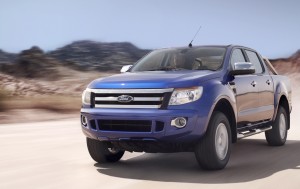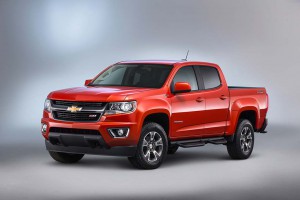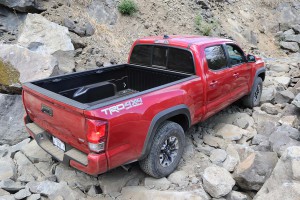Ford may be ready to do an about face and return to the American midsize passenger car market. After repeatedly insisting that buyers were more interested in full-sized trucks like the company’s big F-150, Ford is reportedly preparing a U.S. version of the midsize Ranger model it launched overseas two years ago.
The move appears to be triggered by the unexpectedly strong response to the all-new Chevrolet Colorado and GMC Canyon models General Motors launched last year. Ford abandoned the segment in 2011 when it stopped production of the older version of its Ranger. It has frequently said the new model was not intended for the North American market, but a revised version is apparently under development.
The move not only could fill a big hole in Ford’s otherwise strong and profitable line-up but also solve a political problem for the carmaker as it races to reach a settlement with the United Auto Workers. The two sides have until September 14th to reach a new four-year contract, and a potential sticking point was Ford’s earlier announcement it would end production in Michigan of two compact models. The same plant now appears likely to handle the new Ranger.
Ford issued a non-denial when asked about the reports which apparently were triggered by insiders involved in the UAW contract talks. “We will move production of the next-generation Ford Focus and C-MAX, which currently are built at Michigan Assembly Plant, beginning in 2018. We actively are pursuing future vehicle alternatives to produce at Michigan Assembly and will discuss this issue with UAW leadership as part of the upcoming negotiations.”
(Chevy, GMC hope to expand appeal of Colorado, Canyon twins with new diesel drivetrains. Click Herefor the latest.)
While Ford had not specifically announced its future plans for the Focus and C-Max models, it is widely expected that they will be moved to a new plant in Mexico. That has triggered another headache for Ford, outspoken GOP presidential candidate Donald Trump making Ford’s Mexican operations a key issue in his campaign.
The 2011 demise of the old Ranger was no surprise. For one thing, the pickup had not been updated in a number of years and it would have needed a major overhaul to meet new federal safety requirements, never mind consumer demand. Sales of midsize trucks, meanwhile, had declined by nearly 90% since the peak years in the early 1980s, and Ford officials contended that with little gap in pricing, midsize buyers could readily be converted to full-size F-Series owners.
But the maker apparently under-estimated the impact of the new General Motors models which have spurred a flurry of interest in the segment, along with a surge of sales for GM which also had briefly abandoned the segment.
Competition is now expected to heat up according to analysts such as Stephanie Brinley of IHS Automotive.
Toyota has seen a big surge in demand this year, just as it gets ready to launch a new version of its own Tacoma model. Nissan, meanwhile, is working up a remake of its Frontier pickup.
(Click Here for a review of the redesigned 2016 Toyota Tacoma.)
Other entries are coming. Honda, which pulled the plug on its unusual, car-based Ridgeline two years ago, will be back with an all-new version soon. And Hyundai’s U.S. CEO Dave Zuchowski recently told TheDetroitBureau.com that he strongly expects to win approval for the maker’s own pickup, a production version of its Santa Cruz concept.
Officials at Fiat Chrysler say they’re continuing to look at their own options for a return to the midsize pickup segment.
(For more on the Hyundai Santa Cruz, Click Here.)
While Ford has a midsize model it markets in much of the world, the question is just how much of a change will need to be made to market it here in North America. CEO Mark Fields previously told TheDetroitBureau.com the global version is too expensive to produce in order to maintain a reasonable price gap between a U.S. Ranger and the well-established F-Series full-size truck.
How Ford will lower production costs is uncertain but it could mean “de-contenting” the American Ranger. The richer design and higher content overseas wasn’t a problem because global demand for the full-size F-Series is minimal, the truck too large for most foreign markets.
How soon a new Ranger might come to the U.S. is uncertain, but the Focus and C-Max models were expected to move out of the Wayne Assembly Plant by 2018.
(Mike Strong contributed to this report.)




I think Ford could just forget about it, and concentrate on reducing the price point on a basic F-150, with a manual transmission….Unless they can import the Ranger model that the Afghan Army used in 2006. Fairly basic manual transmission, with a 4 cylinder diesel engine that probably wouldn’t meet EPA emission standards.
I think there is a big demand for a small truck in the US.
Not everyone wants a full size truck, for many of us, a full size is just too big, a pain to park, to big in traffic, just plain too big. Its not the gas mileage, I don’t care if the F150 got 30 MPG, its the size thats just too damned big.
The Ranger was just about perfect size wise, I really hope we get the turbo diesel 4 cylinder here.